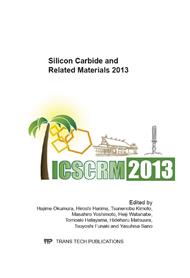[1]
J. P. Bergman, H. Lendenmann, P. Å. Nilsson, U. Lindefelt, and P. Skytt: Mater. Sci. Forum Vol. 353-356 (2001), p.299.
DOI: 10.4028/www.scientific.net/msf.353-356.299
Google Scholar
[2]
H. Lendenmann, F. Dahlquist, N. Johansson, R. Söderholm, P. Å. Nilsson, J. P. Bergman, and P. Skytt: Mater. Sci. Forum Vol. 353-356 (2001), p.727.
DOI: 10.4028/www.scientific.net/msf.353-356.727
Google Scholar
[3]
S. Ha, M. Benamara, M. Skowronski, and H. Lendenmann: Appl. Phys. Lett. Vol. 83 (2003), p.4957.
Google Scholar
[4]
M. Skowronski, J. Q. Liu, W. M. Vetter, M. Dudley, C. Hallin, and H. Lendenmann: J. Appl. Phys. Vol. 92 (2002), p.4699.
Google Scholar
[5]
R. Hirano, Y. Sato, H. Tsuchida, M. Tajima, K.M. Itoh, and K. Maeda: Appl. Phys. Express Vol. 5 (2012), p.091302.
DOI: 10.1143/apex.5.091302
Google Scholar
[6]
A. Galeckas, J. Linnros, and P. Pirouz: Phys. Rev. Lett. Vol. 96 (2006) p.025502.
Google Scholar
[7]
A. Galeckas, J. Linnros, and P. Pirouz: Appl. Phys. Lett. Vol. 81 (2002), p.883.
Google Scholar
[8]
A. O. Konstantinov and H. Bleichner: Appl. Phys. Lett. Vol. 71 (1997), p.3700.
Google Scholar
[9]
K. X. Liu, R. E. Stahlbush, S. I. Maximenko, and J. D. Caldwell: Appl. Phys. Lett. Vol. 90 (2007), p.153503.
Google Scholar
[10]
M. Suezawa, Y. Sasaki, Y. Nishina, and K. Sumino: Jpn. J. Appl. Phys. Vol. 20 (1981), p. L537.
DOI: 10.1143/jjap.20.l537
Google Scholar
[11]
E. Depraetere, D. Vignaud, and J. L. Farvacque: Solid State Commun. Vol. 64 (1987), p.1465.
Google Scholar
[12]
I. Kiflawi and A. R. Lang: Philos. Mag. Vol. 30 (1974), p.219.
Google Scholar
[13]
N. Yamamoto, J. C. H. Spence, and D. Fathy: Philos. Mag. B Vol. 49 (1984), p.609.
Google Scholar
[14]
H. Sugimoto and M. Tajima: Jpn. J. Appl. Phys. Vol. 46 (2007), p. L339.
Google Scholar
[15]
M. P. Peloso, B. Hoex, and A. G. Aberle: Appl. Phys. Lett. Vol. 98 (2011), p.171914.
Google Scholar
[16]
N. A. Mahadik, R. E. Stahlbush, J. D. Caldwell, and K. D. Hobart: Mater. Sci. Forum Vol. 717-720 (2012), p.391.
Google Scholar
[17]
Y. Ohno, I. Yonenaga, K. Miyao, K. Maeda, and H. Tsuchida: Appl. Phys. Lett. Vol. 101 (2012), p.042102.
Google Scholar
[18]
M. Razumova and V. Khotyaintsev: Phys. Status Solidi B Vol. 174 (1992), p.165.
Google Scholar
[19]
T. A. G. Eberlein, R. Jones, A. T. Blumenau, S. Öberg, and P. R. Briddon: Physica Status Solidi C Vol. 4 (2007), p.2923.
DOI: 10.1002/pssc.200775437
Google Scholar


